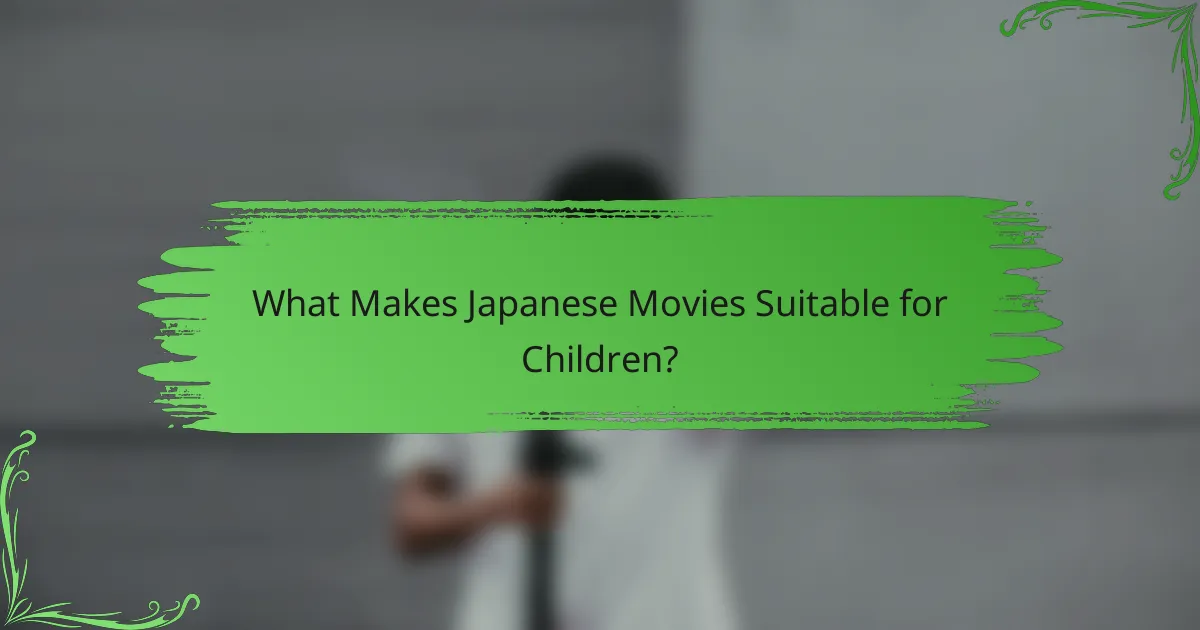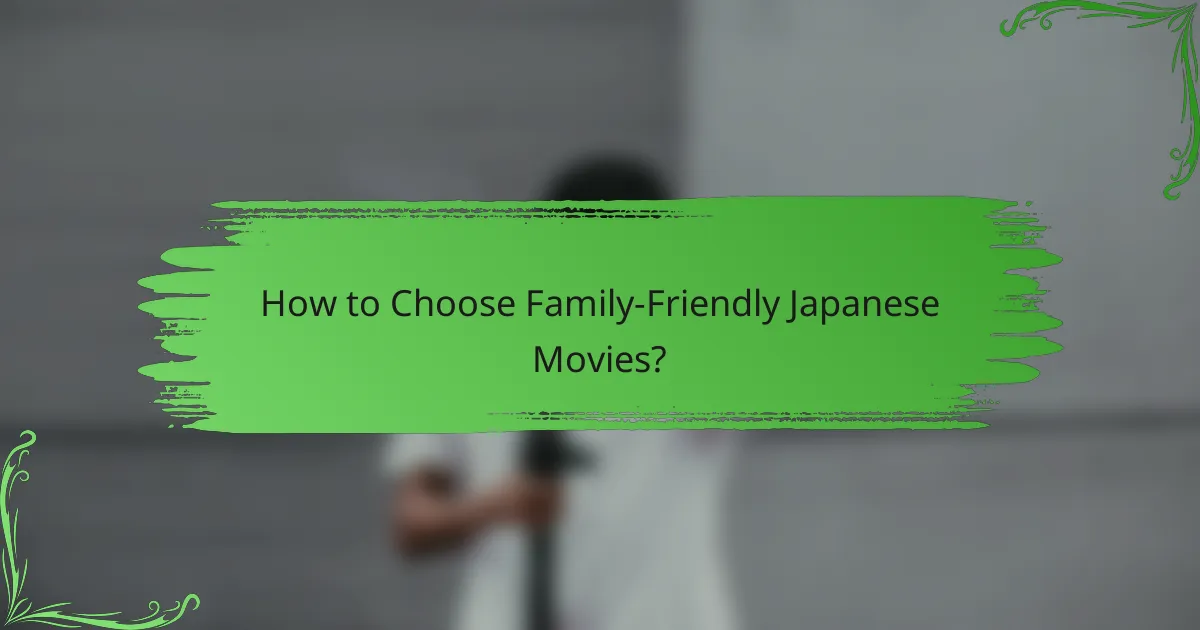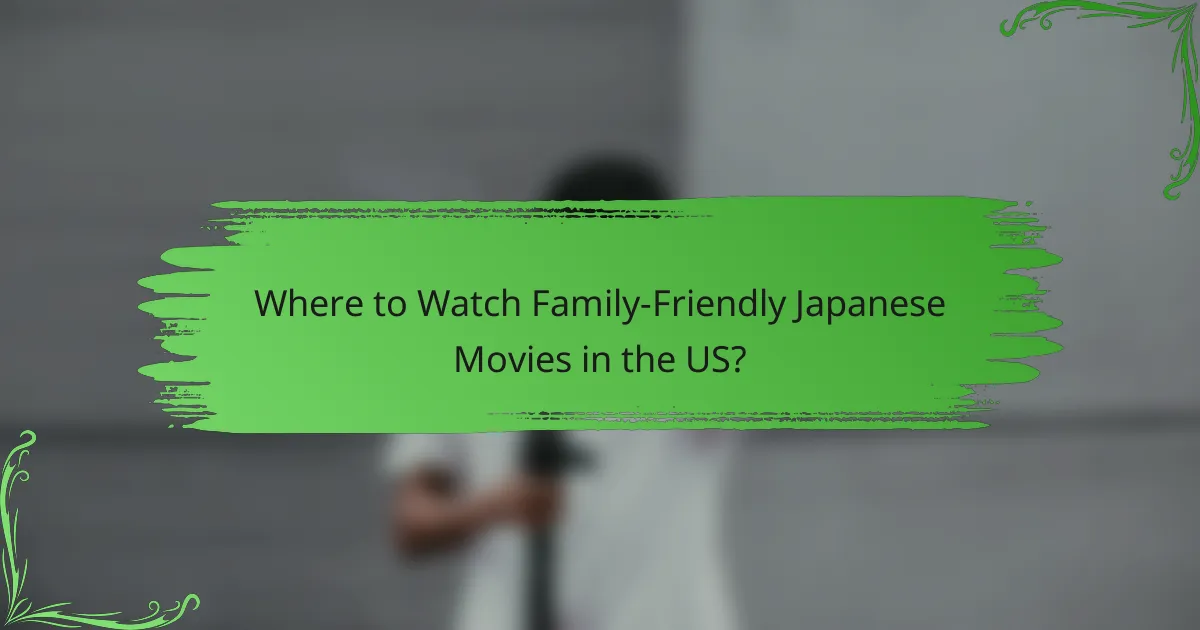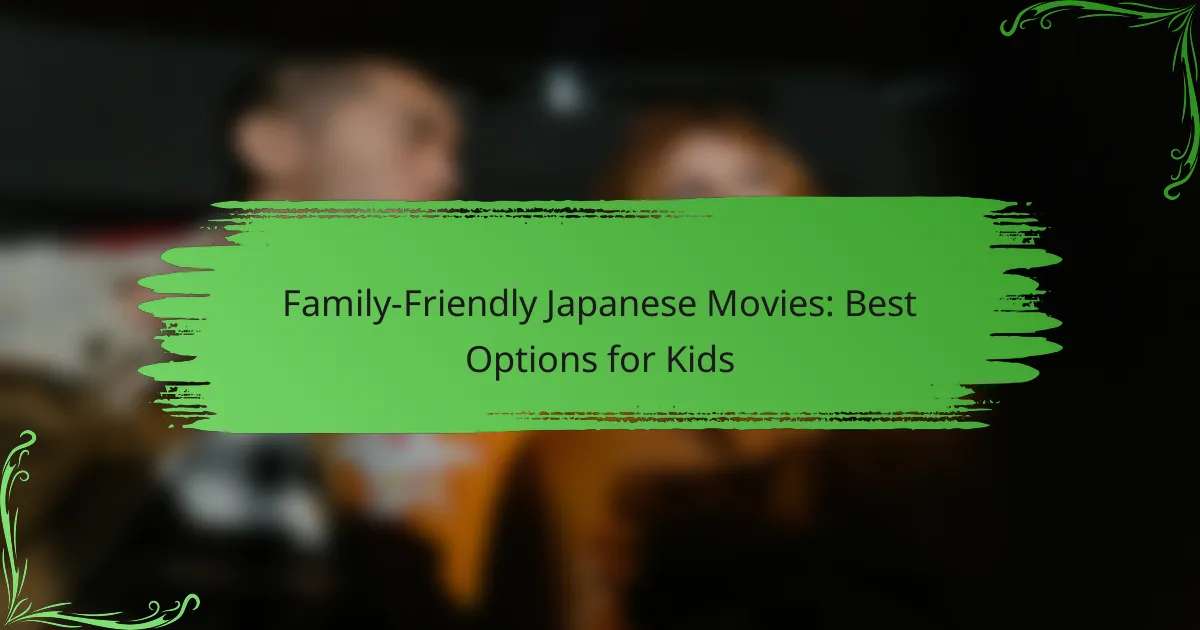Family-friendly Japanese movies offer enchanting stories that captivate young audiences with imaginative worlds and relatable characters. These films not only entertain but also impart valuable life lessons, emphasizing themes of friendship, courage, and family. When selecting these movies, it’s important to consider age appropriateness and content themes to ensure a meaningful viewing experience for children.

What Are the Best Family-Friendly Japanese Movies for Kids?
Some of the best family-friendly Japanese movies for kids include enchanting stories that captivate young audiences while delivering valuable life lessons. These films often feature imaginative worlds, relatable characters, and themes of friendship, courage, and family.
My Neighbor Totoro
My Neighbor Totoro is a beloved classic that follows the adventures of two young sisters who move to the countryside and encounter friendly forest spirits. The film emphasizes the importance of family, nature, and imagination, making it a perfect choice for children.
With its gentle pacing and stunning animation, this movie is suitable for kids of all ages. Parents appreciate its heartwarming storyline and the iconic character, Totoro, who has become a symbol of Japanese animation.
Spirited Away
Spirited Away tells the story of a young girl who becomes trapped in a mysterious spirit world and must find a way to save her parents. This film is renowned for its breathtaking visuals and intricate storytelling, appealing to both children and adults.
While it contains some darker themes, the film ultimately conveys messages about bravery, friendship, and self-discovery. It is recommended for older children due to some intense scenes, but it remains a must-watch for its artistic brilliance.
Ponyo
Ponyo is a whimsical tale about a goldfish who dreams of becoming human after befriending a young boy. This film is vibrant and playful, showcasing themes of love and the bond between friends.
The animation style is unique, resembling a watercolor painting, which adds to its charm. Ponyo is suitable for younger audiences, making it an ideal family film that encourages imagination and adventure.
Howl’s Moving Castle
Howl’s Moving Castle features a young woman cursed by a witch who transforms her into an elderly lady. The story follows her journey to break the curse and her encounters with the enigmatic wizard Howl.
This film combines fantasy with anti-war themes, making it appealing to older children and teens. Its rich visuals and complex characters provide a captivating experience that sparks discussions about courage and identity.
The Secret World of Arrietty
The Secret World of Arrietty tells the story of tiny people living secretly in a human household. Arrietty, a young borrower, forms a friendship with a human boy, highlighting themes of friendship and acceptance.
This film is beautifully animated and offers a gentle narrative that is suitable for younger viewers. It encourages children to appreciate the small wonders of life and the importance of understanding others.

What Makes Japanese Movies Suitable for Children?
Japanese movies are often suitable for children due to their engaging narratives, positive themes, and stunning animation. These films typically emphasize creativity and imagination while promoting values such as friendship, respect, and perseverance.
Engaging Storylines
Many Japanese films for kids feature captivating storylines that draw young audiences in. These narratives often blend fantasy with everyday life, allowing children to explore new worlds while relating to the characters’ experiences. For instance, movies like “My Neighbor Totoro” and “Spirited Away” present adventures that spark curiosity and wonder.
When selecting a film, consider the age-appropriateness of the storyline. Look for movies that maintain a balance between excitement and relatability, ensuring that children can connect with the characters and their journeys.
Positive Messages
Japanese children’s movies frequently convey uplifting messages that resonate with young viewers. Themes of friendship, courage, and environmental stewardship are common, encouraging children to think positively and act kindly. For example, “Ponyo” highlights the importance of love and understanding across different worlds.
Parents should look for films that not only entertain but also instill valuable life lessons. Engaging in discussions about the messages after watching can further reinforce these positive themes.
Beautiful Animation
The animation in Japanese films is often visually stunning, characterized by vibrant colors and imaginative designs. Studios like Studio Ghibli are renowned for their artistic quality, creating immersive experiences that captivate children and adults alike. The intricate details in films such as “Howl’s Moving Castle” and “Kiki’s Delivery Service” enhance the storytelling.
When choosing a movie, consider the animation style that might appeal most to your child. Films with rich visuals can stimulate creativity and inspire young viewers to appreciate art and storytelling in new ways.

How to Choose Family-Friendly Japanese Movies?
Choosing family-friendly Japanese movies involves considering age appropriateness, content themes, and viewer ratings. This ensures that the films are suitable for children while providing engaging and meaningful experiences.
Age Appropriateness
When selecting Japanese movies for kids, age appropriateness is crucial. Look for films that are specifically rated for children, typically categorized as suitable for ages 5 and up. For younger audiences, consider animated features that are visually engaging and have simple storylines.
Check the age ratings provided by organizations like the Japan Movie Classification and Rating Organization (JMCRO), which can guide you in selecting films that align with your child’s maturity level. For example, movies rated G (General Audience) are ideal for all ages.
Content Themes
Content themes in family-friendly Japanese movies often revolve around friendship, adventure, and personal growth. Many films incorporate cultural elements, such as folklore and traditional values, which can enrich children’s understanding of Japan.
Be mindful of themes that may not be suitable for younger viewers, such as loss or complex moral dilemmas. Look for films that emphasize positive messages, like teamwork and perseverance, which can be both entertaining and educational.
Viewer Ratings
Viewer ratings can provide insight into how well a movie is received by audiences, including families. Websites like IMDb and Rotten Tomatoes offer ratings and reviews that can help you gauge a film’s popularity and suitability for children.
Consider films with high audience scores, typically above 70%, as these are often well-received by families. Additionally, reading reviews can help you understand specific content that may be of concern, ensuring you choose movies that align with your family’s values.

Where to Watch Family-Friendly Japanese Movies in the US?
Family-friendly Japanese movies can be found across various platforms in the US, making it easy for parents to access quality content for their children. Popular streaming services, DVD options, and cable networks all offer a selection of these films, catering to different viewing preferences.
Streaming Services
Several streaming services provide a rich library of family-friendly Japanese movies. Platforms like Netflix, Hulu, and Amazon Prime Video often feature popular titles, including Studio Ghibli classics and newer animated films. Subscription costs typically range from $8 to $15 per month, depending on the service and plan chosen.
When selecting a streaming service, consider the availability of specific titles and whether the platform offers a free trial. This can help you determine if it meets your family’s viewing needs before committing to a subscription.
DVD Availability
DVDs of family-friendly Japanese movies can be purchased or rented from various retailers and online stores. Major retailers like Walmart, Target, and Best Buy often carry popular titles, while online platforms such as Amazon provide a wider selection, including special editions and box sets.
Prices for DVDs typically range from $10 to $30, depending on the title and format. Look for sales or bundles to save money, especially during holiday seasons or promotional events.
Cable Networks
Cable networks such as HBO and Cartoon Network occasionally air family-friendly Japanese movies, particularly during special programming blocks or film festivals. Checking the schedule regularly can help you catch these films when they are broadcast.
Additionally, some cable providers offer on-demand options, allowing you to rent or purchase specific titles directly through your television service. This can be a convenient way to access films without needing a separate subscription or physical media.

What Are the Cultural Themes in Japanese Kids’ Movies?
Japanese kids’ movies often explore rich cultural themes that reflect the values and traditions of Japan. Common themes include respect for nature, family bonds, and the importance of community, which resonate with children and adults alike.
Nature and Environment
Nature and the environment are central themes in many Japanese children’s films. These movies often depict the beauty of the natural world, emphasizing the connection between humans and nature. For instance, films like “My Neighbor Totoro” showcase lush landscapes and the importance of preserving the environment.
In addition to visual storytelling, these films often convey messages about environmental stewardship. They encourage young viewers to appreciate nature and understand their role in protecting it. This can inspire children to engage in eco-friendly practices, such as recycling or planting trees.
Parents can use these films as a starting point for discussions about environmental issues. Watching together can lead to conversations about local wildlife, conservation efforts, and the impact of climate change, fostering a sense of responsibility in children.
